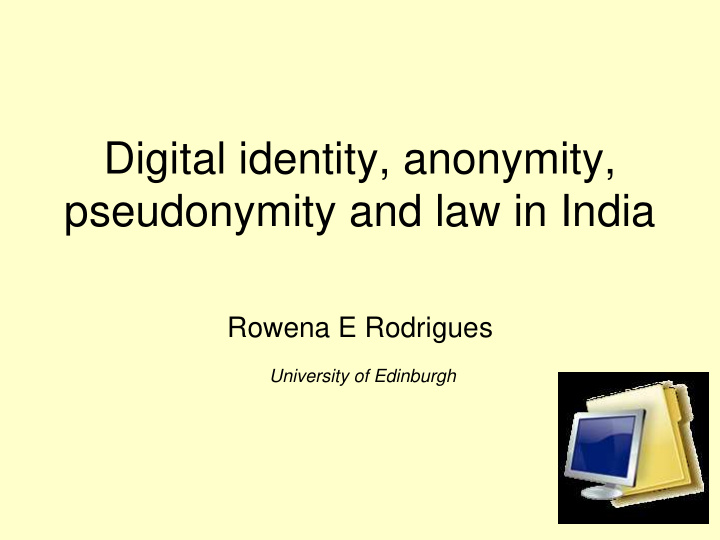



Digital identity, anonymity, pseudonymity and law in India Rowena E Rodrigues University of Edinburgh
Digital India • Increase in Internet usage and penetration • Cyber cafés • Telecentres • Home Use • Other applications • Popular uses: email, chat, social networking, blogging, gaming, digital radio, matrimonial websites, video conferencing, digital radio
A country like no other RELIGION INVASIONS CULTURE FAMILY COLONISATION SATELLITES TRADITION CUSTOMS CULTURE SUPERCOMPUTERS ASSIMILATION CLASS SECULAR DEMOCRATIC SOCIAL REPUBLIC CASTE
The concept of identity • Influenced by history, geography, culture, tradition, caste, class • Identity as a whole and a sub-set: *regional identity *state identity *religion *language *caste and class *family
Development of identity • Unity in pluralism (Brahmannical triad) • Swaraj (self-rule) • Influence of reservation policies • Judicial developments KM Patil v Addl Commissioner Tribal Development and Ors (1994) Mrs V Paul v Cochin University & Ors (1996)
Anonymity and Pseudonymity • Renunciation of identity – normal and traditional phenomena • Assumption of pseudonyms • Abandonment of identity for socially and economically beneficial reasons - gender, caste, class distinctions
Manifestations • Email • Newsgroup, bulletin boards, chat rooms • Social networking sites e.g. Orkut, matrimonial sites • ID cards e.g. Voters cards, MNIC • Rural networking e.g. India’s knowledge village Hansdehar
India’s knowledge village
Manifestations Anonymity and pseudonymity on the web ◈ Multiplicity of email addresses ◈ Lack of use of anonymisers and anonymous surfing services ~ time constraint ~ non-perception of need ~ awareness ~ general social mindset built on openness and information sharing ~ single sign on, multiple identities
Regulation and effects • The Information Technology Act 2000 • Relevant cases: -The case of the Cyber Stalker -State of Tamil Nadu v S Katti -NASCOMM v Ajay Sood (phishing) • Government attempts to regulate: Introduction of photo-id requirement for cyber café users (2006) Priority Reporting Tool with Orkut
THE MNIC • Rolled out in May 2007 • Individual identification system • Purposes: prepare a NPR (National Population Register) and NRIC (National Register of Indian Citizens); provide a national identification number; • Mandate: deal with illegal migration and for efficient e-governance
THE DATABASE AND ITS LINKS
The MNIC – legal mandate and issues Citizenship Act 1955 amended – compulsory registration for all (2003) � No express legislative safeguards to deal with consequential problems � Control to the bureaucracy and government � Lack of documents to prove residence, birth (common problems) � Has not been subject to informed public debate and its pros and cons have not been thoroughly weighed
More issues • Input and data correction • (Fear of) misuse, function creep • Lack of transparency • Lack of redressal mechanisms • Positive discrimination • Database security and maintenance • Privacy and DP fallout of the linkage of databases
The future • DI, anonymity and pseudonymity will develop and grow as Internet usage increases so will issues • Judicial activism and precedents • Need for increased awareness, informed academic interdisciplinary contributions to this area of research • Legislators and policy makers need to take into account the interests of the different stakeholders
Recommend
More recommend